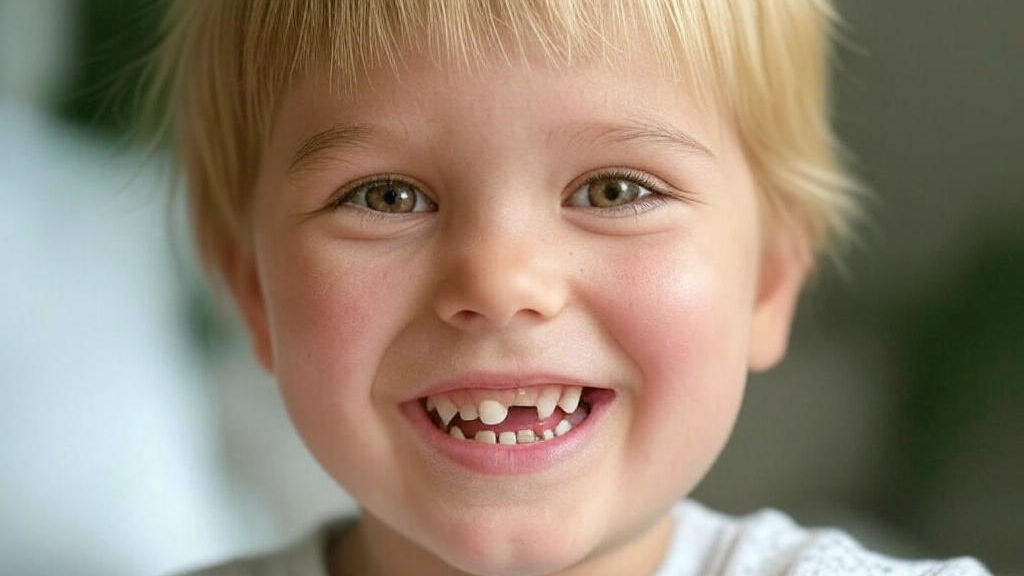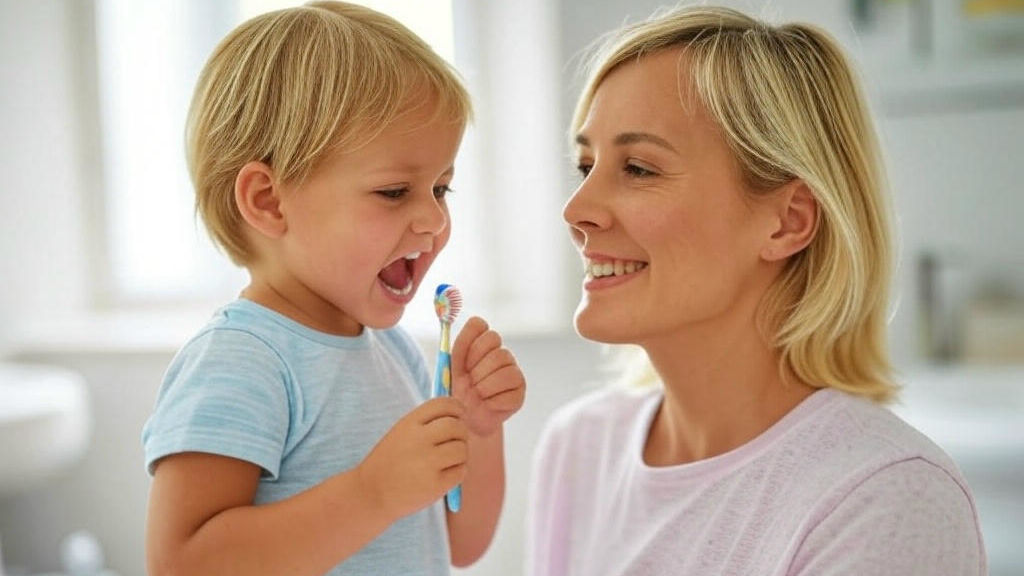Contents

Baby Teeth: A Complete 2025 Guide for Parents (Eruption, Loss, Care, Problems & FAQ)
The arrival of a baby's first teeth is a major milestone! These famous baby teeth, also known as primary or deciduous teeth, play a much more important role than is often thought. They are essential for eating, speech development, facial aesthetics, and most importantly, they prepare the way for the future permanent teeth.
When exactly do they appear? How many are there and in what order? At what age and how do they fall out? What should you do in case of a cavity, a knock, or if a tooth is late to fall out? How should you care for them daily? This complete and updated guide answers all the questions parents have about their children's baby teeth.
Baby Teeth at a Glance
These are the 20 first teeth of a child, crucial for eating, speaking, and guiding permanent teeth. They appear between 4 months and 3 years and fall out between 6 and 12 years. They are fragile and require brushing from the very first tooth and regular dental visits.
Definition and Importance of Baby Teeth
Baby teeth (or deciduous teeth) are the first set of teeth in human development. Although they are destined to be replaced, their role is fundamental:
- Chewing and Nutrition: They allow the transition to solid foods.
- Speech Development: They are essential for the proper articulation of sounds.
- Aesthetics and Confidence: They shape a child's smile and face.
- Space Maintenance: Each baby tooth holds the precise space for the corresponding permanent tooth, preventing other teeth from shifting.
- Eruption Guide: They guide the permanent teeth into their correct positions.
- Jaw Development: Chewing with baby teeth stimulates the harmonious growth of the jawbones.
Neglecting baby teeth can therefore have long-term negative consequences on oral health.
When and How Do Baby Teeth Erupt?
The eruption of baby teeth, or "teething," begins on average around 6 months of age, but there is wide variability (as early as 4 months or after 1 year). It is even possible, though very rare, for babies to be born with one or two teeth (natal teeth).
Here is an indicative eruption timeline for the 20 baby teeth:
| Type of Baby Tooth | Average Age of Eruption |
|---|---|
| Lower Central Incisors | 6 - 10 months |
| Upper Central Incisors | 8 - 13 months |
| Upper Lateral Incisors | 9 - 13 months |
| Lower Lateral Incisors | 7 - 16 months |
| Upper First Molars | 13 - 19 months |
| Lower First Molars | 12 - 18 months |
| Upper Canines | 16 - 22 months |
| Lower Canines | 16 - 23 months |
| Lower Second Molars | 20 - 31 months |
| Upper Second Molars | 25 - 33 months |
The full set of baby teeth is generally complete by the age of 3 years.
Managing Teething Symptoms
This period can be accompanied by discomfort: red and swollen gums, excessive drooling, irritability, a need to chew, red cheeks, and disrupted sleep and appetite. To soothe your baby:
- Offer a clean, refrigerated teething ring (never frozen).
- Gently massage their gums with a clean finger or a damp cloth.
- Give them cooler or easy-to-chew foods if their appetite decreases.
- Regularly wipe their face to prevent irritation from saliva.
If there is a high fever or other symptoms (diarrhea, vomiting), consult your pediatrician, as it is likely not just due to teething.
When and How Do Baby Teeth Fall Out?
The loss of baby teeth begins around 6 years old, marking the start of the mixed dentition phase, and continues until 11-12 years old. The underlying permanent tooth pushes up, causing the root of the baby tooth to resorb, making it loose until it falls out.
Here is the average order and age of loss:
| Type of Baby Tooth | Average Age of Loss |
|---|---|
| Central Incisors (lower then upper) | 6 - 7 years |
| Lateral Incisors | 7 - 8 years |
| First Molars | 9 - 11 years |
| Canines | 10 - 12 years |
| Second Molars | 10 - 12 years |
By around age 12-13, a child has typically lost all 20 baby teeth and has 28 permanent teeth (the 4 wisdom teeth will arrive much later, if at all).
The tradition of the "Tooth Fairy" is a fun rite of passage for many children, helping to make losing teeth a positive experience.
Common Problems with Baby Teeth and Solutions
Several issues can affect these temporary teeth.
Tooth Decay (Baby Bottle Tooth Decay)
The number one enemy! The thinner enamel makes baby teeth very susceptible to acid attacks produced by bacteria from sugar. "Baby bottle tooth decay" often affects the front teeth of toddlers due to prolonged use of sugary bottles (milk, juice), especially at night.
Risks: Pain, infection (abscess), damage to the permanent tooth bud, loss of space.
What to do? See a dentist to treat the cavity (often with a white composite filling, sometimes a preformed crown or rarely a pulpotomy/partial root canal if the nerve is affected). Prevention is key: rigorous hygiene, limiting sugar, and no bottles in bed.
Trauma (Bumps, Falls)
- Loose Tooth (Luxation): See the dentist. They will assess the situation. Sometimes the tooth stabilizes on its own; other times, a temporary splint or extraction is necessary.
- Knocked-Out Tooth: Do not try to reinsert it! Rinse it gently with water or saline without rubbing the root, store it in milk or saline (or the child's saliva), and go to the dentist immediately. They will decide on the course of action (reimplantation is rarely indicated for a baby tooth).
- Broken Tooth: See the dentist quickly. They will check for nerve and root damage with an X-ray. If it's a simple fracture, a cosmetic repair is possible. If the root is affected or the nerve is exposed, extraction is often necessary.
- Gray/Dark Tooth (Necrosis): Indicates internal bleeding or nerve death. Monitoring is essential. If an abscess (white bump) appears on the gum, extraction is required to protect the permanent tooth.
Dental Trauma Emergency
After any blow to the teeth, even without immediate visible signs, a prompt visit to the dentist is recommended to assess potential damage to the root or the permanent tooth bud.
Anomalies in Shedding and Eruption
- Baby tooth that doesn't fall out: May be due to the absence of the permanent tooth (agenesis, confirmed by X-ray) or a blockage/delay. The dentist will decide on the appropriate action.
- Permanent tooth behind the baby tooth ("shark teeth"): Encourage the child to wiggle the baby tooth. If it persists, the dentist will remove it to make space.
- Premature loss: The dentist may place a space maintainer to prevent neighboring teeth from closing the gap.
Baby Teeth vs. Permanent Teeth: Key Differences
They differ in:
- Number: 20 vs. 32 (or 28).
- Size: Smaller.
- Color: Whiter ("milky").
- Structure: Thinner, less mineralized enamel and dentin (more fragile).
- Roots: Shorter, thinner roots that resorb.
- Pulp (Nerve): Proportionally larger (cavities reach it faster).
Caring for Baby Teeth: Good Habits
The health of baby teeth greatly depends on habits formed from a very young age.
Daily Hygiene
- Clean the infant's gums with a damp cloth even before teeth erupt.
- Brush as soon as the first tooth appears, twice a day (morning and after the last meal of the evening).
- Use a small-headed, ultra-soft bristled toothbrush appropriate for the child's age.
- Use a fluoride toothpaste: a smear or rice grain-sized amount up to age 3, then a pea-sized amount. Fluoride is the most effective agent against cavities.
- The parent should do the brushing until age 2-3, then supervise and re-brush effectively after the child until around 7-8 years old.
Balanced Diet
- Drastically limit the frequency and quantity of added sugars (cookies, candy, cakes, syrups).
- Be wary of hidden sugars in many processed foods. Read labels.
- Prioritize water as the only drink between meals and at night.
- Avoid sodas, fruit juices (even 100% pure juice), and flavored milks, which are highly cariogenic.
- Never let a child fall asleep with a bottle containing anything other than plain water.
- Avoid sugary or acidic snacking between main meals.
Regular Dentist Visits
- Make the first visit around age 1, or no later than 6 months after the first tooth erupts. This early visit helps to identify potential risks, provide personalized advice, and gently acclimate the child.
- Establish regular check-ups, usually annually or semi-annually, as recommended by your dentist.

Interceptive Orthodontics and Baby Teeth
While traditional orthodontics (braces, aligners) doesn't target baby teeth, interceptive orthodontics (often around age 7) may be indicated during the mixed dentition phase. It aims to correct early developmental problems with the jaws or functions (breathing, swallowing) to ensure better growth and simplify any future treatment on permanent teeth.
Conclusion: Cherish These Temporary Teeth!
Baby teeth are essential for a child's development and the health of their future permanent teeth. Good hygiene habits, a healthy diet, and regular dental follow-up from a young age are crucial. Do not hesitate to consult a dentist with any concerns.
Frequently Asked Questions (FAQ) about Baby Teeth
Q: How many baby teeth does a child lose?
A: All 20 initial baby teeth fall out to be replaced.
Q: Should we save fallen baby teeth?
A: Storing them for stem cells is a research area but is not a standard or routinely recommended medical practice. For most, they are a keepsake or for the Tooth Fairy!
Q: My child swallowed their baby tooth, is it dangerous?
A: No, it is not dangerous at all. It is common, and the tooth will pass naturally.
Q: Can a cavity in a baby tooth really damage the permanent tooth?
A: Yes. An untreated infection (abscess) can damage the bud of the permanent tooth that lies just below it in the bone.
Q: When should the very first dentist visit be?
A: The current recommendation is around age 1, or no later than 6 months after the first tooth erupts. It is essential for prevention and to get the child used to the environment.
Q: Should we pull a very loose baby tooth?
A: Generally, no. It is best to let the tooth fall out naturally. Pulling it can break the root or injure the gum. Encourage the child to wiggle it gently. Consult the dentist if the tooth is painful, interferes with eating, or if the permanent tooth is erupting behind it.
